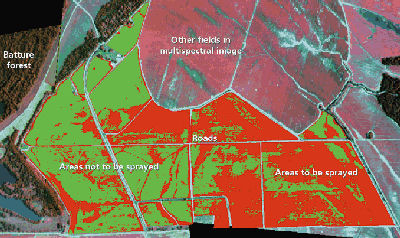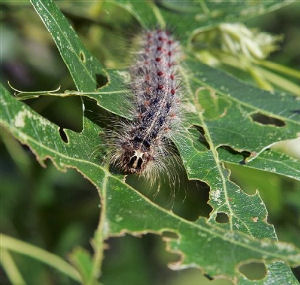1. Monitoring Crop Status
Combating disease and pests
In addition to identifying plants under stress from lack of nutrients or water, remote sensing can also assist in protecting the plants from potential attacks of pests, fungi or bacteria. By combining agricultural knowledge with remotely sensed data, it is possible to have early warning and prevent a pest or a disease from affecting the crops, by taking appropriate action at an early stage.

Source: Environmental Health Perspectives, Volume 108 (3), March 2000
The above multispectral image shows cotton plants that because of favourable conditions, are growing faster than others. These plants (appearing in red) are the most probable targets for an attack of pests or diseases at this particular moment in time. With this knowledge, pesticides need only be applied at the highlighted areas, reducing the cost of the treatment and most importantly the amount of chemicals released to the environment.
It is also possible to assess the extent of the damage caused by pests and diseases, by using similar methods to those used to identify stressed plants. The symptoms of such attacks, usually cause the break-down of chlorophyll, and as shown before, we can identify the reduction of chlorophyll concentration in the plants through remote sensing.
Question: Look at the patterns on the image above. Can you explain why some cotton plants are growing faster than others?

Source: Mel Evans, Associated Press
In addition to loss of chlorophyll, pest and diseases can cause the destruction of whole leaves. This leads to a reduction in the total leaf area and as a result, the reduction of the plant's capacity for photosynthesis. As we are able to estimate the Leaf Area Index (LAI) of a group of plants, it is possible to identify an insect attack (such as the one of moth larvae seen above) at an early stage and warn the farmers to take the appropriate measures.
Remote sensing can help identify the plants mostly in need of fertilisers or pesticides and assist in reducing the amount of those chemicals that are used in a crop management regime. For more information see the module on Precision Agriculture.
